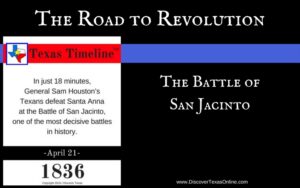
I’m doing a short series about the value of timelines.
They’re not as “boring” as you might think!
Timelines are very useful in helping us to understand cause and effect…and that often helps us to understand a much more interesting and complex story.
People do things for a reason.
As much as we’d like to think that “our side” has “the best reason,” chances are very good that the “other” side has reasons that seem very good to them, too!
Take, for example, the events leading up to the Texas Revolution:
1801 – Relations between Spain and the United States were pretty good…sort of. Spain and England were at war at many points in history, so while the Colonies belonged to the British, Spain kept a close eye on things. But after the American Revolution, Spain tentatively trusted the new country next door. When Philip Nolan asked to cross the Texas border to round up stray horses, Spain granted permission…until they learned he had first met with American President Thomas Jefferson and was spending a good deal of his time making maps. Understandably peeved, Spain nonetheless over-reacted by executing Nolan, which did nothing to improve relationships.
1803 – When Spain and France ended their long war, Spain wound up holding Louisiana. They’d always enjoyed having the French territory as a buffer between Texas and the United States. Spain offered to return Louisiana to France in exchange for certain benefits IF France would promise never to sell the territory to the United States. France agreed…then turned right around and sold the Louisiana Purchase to raise funds for Napoleon’s wars.
1810-1821 – Mexico joined a host of other countries during the Revolutionary Era (see tomorrow’s post) in fighting for independence from Spain. It takes a while, but they win.
1813 – With Mexico distracted by the war, Magee’s Expedition tries to claim Texas independence.
1819 – With Mexico still distracted by war, Long’s Expedition tries to claim Texas independence…twice!
1824 – Newly independent, Mexico writes a constitution modeled after the United States Constitution.
1825 – Mexico need settlers in the far northern regions, so they open immigration to Anglos who eagerly accept the invitation.
1827 – The United States offers to buy Texas from Mexico. Remembering Nolan, Magee, and Long, Mexico is justifiably edgy about Anglos wanting Texas.
1829 – Mier y Teran is sent to investigate the situation. He reports that the Anglo Texans are not keeping their promise to speak Spanish and become Catholics. This is true, but it’s also true that there are no schools yet on the frontier and few churches. Many of the Anglos are newcomers who are just trying to survive.
1830 – In what is possibly another over-reaction, Mexico (Santa Anna) declares an abrupt ban on immigration from the United States, places heavy taxes on the struggling pioneers, and tightens restrictions.
1831-1833 – Anglo and Hispanic Texans make several appeals to Mexico for relief from high taxes and legal restrictions.
1834 – Angered by citizens’ appeals and the general political upheaval in Mexico (between 1833-1855, Mexico had 36 presidents), President Santa Anna declares himself dictator, tosses the Constitution, dismisses congress, and begins to disarm the Mexican people as a precaution.
1835 – Texans, especially, needed their guns to hunt and defend themselves against Indian raids. When the Mexican army came to confiscate their weapons, the people challenged them to “Come and Take It!”
And that’s how the rebellion began.
Who was right? Maybe both sides had reason to take offense. Who was wrong? Almost certainly, Santa Anna. He was a pompous politician who played both parties against each other for his own personal gain and abused his own citizens, no matter where they came from.
Plotting key events on a timeline helps us understand how one thing leads to another, tit for tat, until the events occur closer and closer together and finally there is a point of crisis.
These are good things to notice even in our own times.


